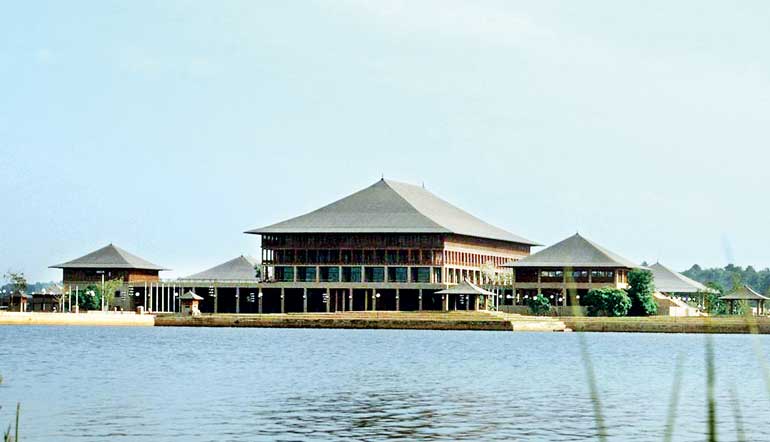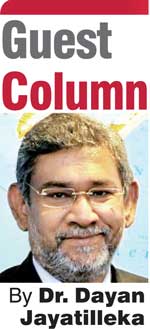Tuesday Dec 16, 2025
Tuesday Dec 16, 2025
Thursday, 12 October 2017 00:00 - - {{hitsCtrl.values.hits}}

How to safeguard political sovereignty and territorial unity by avoiding intervention? Can intervention be avoided without devolution? How to devolve to such a degree so that intervention is deterred rather than attracted? Those are the questions.
Let me place my cards on the table as I usually do: reasonable and moderate devolution is the only realistic safeguard for sovereignty, unity and territorial integrity. If the degree of devolution is excessive as is the case with the dovish UNP-TNA federalising proposals and Chandrika’s 1995/1997 federalist “Package”, disintegration and external absorption will result. Conversely if the degree of devolution is insufficient, as in the case of the counter-proposals of the Sinhala nationalist hawks (such as Prof. Peiris) it will invite resistance and intervention, resulting in the end of territorial integrity, unity and sovereignty. 
The Middle Path and the Golden Mean is to be neither a dove nor hawk, but (as supreme Realist, Dr. Henry Kissinger used to quip) a “dawk” (a hawkish dove or dovish hawk) or its closest equivalent in Nature, an owl.
Prof. Peiris’ quote from Emeritus Prof. K.M. de Silva in a national newspaper on 10 October on the coercive and turbulent circumstances of the signing of the Indo-Lanka accord is profoundly accurate and no less profoundly irrelevant to our debate on devolution. I did not contradict the historical fact that Sri Lanka was coerced into that signing and that the system of provincial devolution became a reality as a result of such external coercion. Why should I deny it when, as the record shows, as a young man in my twenties, I was the first, and the only one at the time, to predict and caution against this interventionist outcome?
The massive and authoritative first volume of the two volume Annotated Bibliography on ‘Ethnic Conflict and Human Rights in Sri Lanka’, edited by Kumar Rupesinghe and Berth Verstappen, published for PRIO (the Peace Research Institute of Oslo) in 1989 by Hans Zell publishers, London/New York, has several entries for the book ‘Sri Lanka: The Ethnic Conflict: Myths, Realities and Perspectives’ edited by the Committee for Rational Development (Colombo) and published by Navrang, New Delhi in 1984.
The bibliography summarises my contribution ‘The Ethnic Conflict and the Crisis in the South’, first published in the Lanka Guardian vol 7 (7) of August 1984 and vol 8(8) of August 1984, as well as in Logos vol 23 (3): Sri Lanka’s ethnic problem: the proceedings of the Bishop Leo Nanayakkara memorial dialogues organised by the Centre for Society and Religion, May-June 1984, and published in October 1984. (Pp. 48-60).
In the paragraph long annotation on my contribution, the PRIO bibliography concludes that “the author [Dayan Jayatilleka] stresses that the various aspects are interrelated. If the present system is not capable of coming up with a solution, there will be either an externally propelled solution or a challenge to the system itself.” (Item No 543, Rupesinghe & Verstappen, p132)
Both predictions – “externally propelled solution” and “challenge to the system” – came true. The “challenge to the system” came two years later, while the prognostication of external intervention was made by me at the CSR symposium in May-June 1984 as well as in print in Logos and the Lanka Guardian, three years BEFORE the Indian intervention and the Indo-Lanka Accord. I was 27 years old.
I might add that as the PRIO Bibliography records, at almost the same time, on May 26-27th 1984, the United Nations University (UNU) South Asian Perspectives Project in association with the Lanka Guardian, held a seminar on “Ethnic Relations and nation Building in Sri Lanka”, attended by 25 religious leaders, scholars, journalists and trade unionists. The Final Report of the seminar recommended that “political structures” be reformed so as to make for autonomous Provincial Councils, for which a list of powers to be devolved was also suggested. I was among the participants and signatories.
Part IV of the four part report was on ‘The International Context’ and drafted primarily by co-chair of the seminar, Lanka Guardian editor Mervyn de Silva. The full report was published in the Lanka Guardian, vol 7(6), July 15th 1984 pp.6-22 and republished as ‘Lankan Crisis: An agenda for non-violent solution’, Nation-building and Regional Cooperation, United Nations University, Asian Perspectives Project (South Asia) July 1984, Dossier No 3, pp. 132-144. (Rupesinghe & Verstappen, item 586, p 143) These recommendations came many months before the All Parties Conference of 1984 was convened by President Jayewardene and Annexure C drafted by Indian envoy G. Parthasarathy Sr.
Prof. Peiris’ invocation of Prof. de Silva’s description is utterly irrelevant to my point and in no way contradicts it. My point was that devolution going beyond the district, indeed transcending district boundaries through the contentious “joinder” of any two or more adjacent districts, had already entered the mainstream political agenda in Sri Lanka, and was hardly introduced by India or any other external player. The evidence is the Bandaranaike-Chelvanayakam Pact of 1957.
If SWRD had been Executive President and not the hapless PM, he would doubtless have implemented the B-C Pact despite the agitation by the Opposition UNP and the Buddhist clergy which had supported him in 1956. Had the B-C Pact been implemented in 1957, we would have had devolution beyond the district from 1957 onwards and not have had Prabhakaran instead, or he would not have been anywhere as effective even if he emerged to wage war. Hundreds of thousands of lives may have been saved. Certainly we would not have had an Indian intervention, the Indo-Lanka accord and the 13th amendment in 1987 and Provincial Councils in 1988, because adequate political reform in the form of provincial autonomy would already have existed.
Indeed had Annexure C, agreed upon by President Jayewardene in 1984 with Indian envoy G Parthasarathy Sr., or the 19 December 1985 proposals of Chidambaram and Natwar Singh, or the purely domestic agreement between President Jayewardene and the Left parties at the PPC in mid-1986, been implemented, there would have been no coercive Indian intervention because there was no need or opportunity for it, and arguably we could have won the war uninterrupted in 1987.
What the Indian coercion did was not to seriously and consequentially introduce the idea of devolution beyond the district into the mainstream political agenda. That had already happened with the B-C Pact in 1957. What the Indian intervention did was to force through the long delayed and deferred implementation of provincial devolution. It was in the nature of a Caesarean operation to deliver something—provincial devolution—that had repeatedly been agreed upon, even pledged, and then blocked or reneged upon, eventually imposing a political risk on Delhi following July 1983. Had we implemented provincial devolution and reduced the intensity of the crisis before it ballooned and impacted upon India’s interests, we could have avoided external intervention.
I made this point well before that traumatic historic event, at the CSR and in Logos and the Lanka Guardian in 1984, that is to say post-July 1983, because it was obvious to me that Delhi was under tremendous Tamil Nadu pressure and would be actively drawn-in, in the post-July 1983 context, if no domestic political solution were implemented speedily.
Of course at the levels of ethics, morality and the principle of sovereignty such intervention was outrageous, but Delhi was under pressure because of the Tamil Nadu factor; a factor which will never go away. States act in accordance with their interests, real or perceived, and the asymmetry of states mean that in the absence of a real, effective strategic counterweight or the ability for protracted resistance, the stronger state prevails. India will always be the stronger state.
This is the lesson that Thucydides tried to impart in his depiction of the dialogue between the Athenian envoys and the leaders of the island of Melos who were well within their moral right to assert their option of remaining neutral, but were cautioned and then crushed. By signing the Indo-Lanka Accord President Jayewardene saved our armed forces and prevented a Melian outcome. It is not for nothing that the so-called “Melian dialogue” is a cornerstone of the Realist school of politics, history and international relations.
All this brings us to the question of where the supra-district unit of devolution entered the discussion from. Why did SWRD Bandaranaike agree to “joinder” across district boundaries in 1957? Why did the Indians arrive at it decades later? Because that was a bottom line of the Tamil parties. Conversely, why didn’t the Indians seek to impose federalism at gunpoint on the Sinhalese? That was because the unitary state was a bottom line of the Sinhalese side. The respective bottom lines remain, and constitute parameters.
These then are the lessons for today, as the debate on Constitutional change rages.
Prof. Peiris and his co-thinkers have yet to discover a single Tamil taker for their project of district level devolution, removal of provincial devolution and the rollback of the powers of 13A. In the absence of a single Tamil political partner for this project, they continue to insist upon it.
If on an island which consists of several communities of uneven size, if any one community tries to implement a model for which there are no takers whatsoever from the other communities, then the vision is not one of dialogue and consensus but of unilateral imposition. This perspective is not one of peaceful coexistence on this shared island based on a relationship of dialogue, negotiation, compromise and mutual accommodation between the Sinhalese and Tamils, the South and the North, the majority and the minority, but precisely one of domination and diktat; of internal colonialism and ethnic/ethno-religious majoritarian supremacism.
What makes Prof. Peiris and those of his ilk think that such a project of supremacism is viable on this island, in this region, in this world and at this stage of history?
Speaking a decade after Black July ’83, in 1993, at a United Nations University seminar, Mervyn de Silva revisited the original UNU-Lanka Guardian collaborative project and recalled that “Prof. Shelton Kodikara…joined this task force on nation-building”. I might add that Prof. Karthigesu Sivathambi was another member. In his 1993 talk, Mervyn summed up his perspective which I have not merely inherited but actively share and wish to remind readers of at the present moment of collective contemplation of Constitutional reform:
“My own approach to the core issue—the harrowing Sri Lankan crisis—betrays, I admit, an internationalist bias. But in this age of ethnicity, break-up of nation-states, steady erosion of national sovereignty, preventive diplomacy, humanitarian intervention and a global communication system that steadily shrinks the world, I do not need to apologise for this line of inquiry.” (Crisis Commentaries, p 171)
Prof. G.H. Peiris has concluded his multi-part response to my articles. I shall, as the author of the original articles which triggered the debate, reciprocate by exercising my right of reply and as convention goes, be the one to put an end to this exchange.